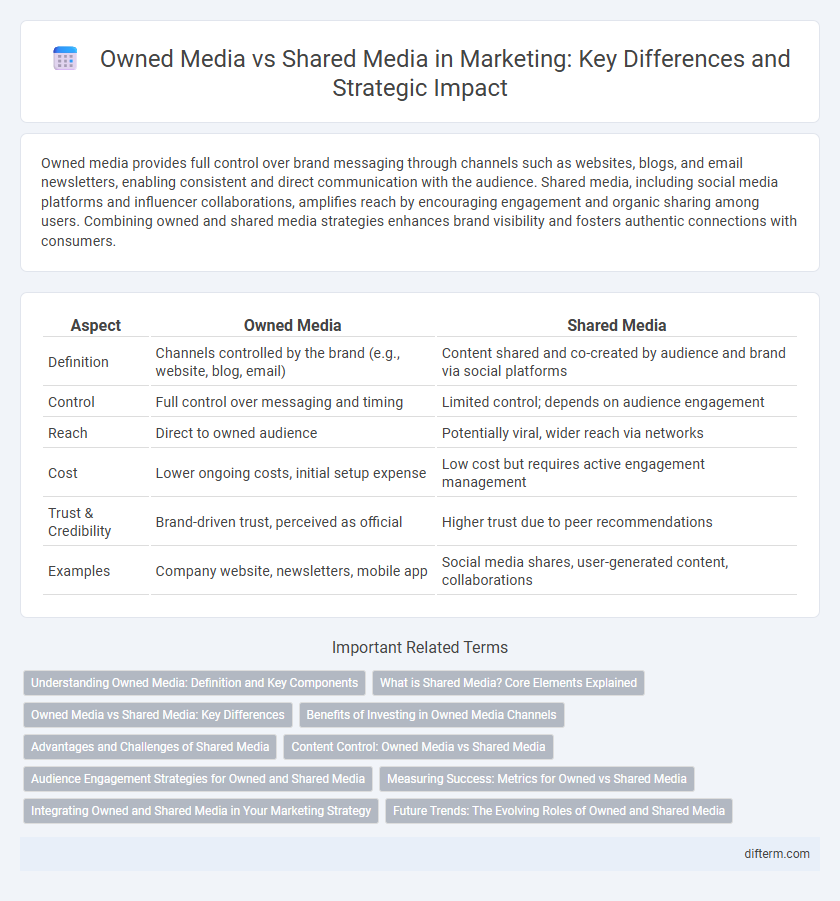Owned media provides full control over brand messaging through channels such as websites, blogs, and email newsletters, enabling consistent and direct communication with the audience. Shared media, including social media platforms and influencer collaborations, amplifies reach by encouraging engagement and organic sharing among users. Combining owned and shared media strategies enhances brand visibility and fosters authentic connections with consumers.
Table of Comparison
| Aspect | Owned Media | Shared Media |
|---|---|---|
| Definition | Channels controlled by the brand (e.g., website, blog, email) | Content shared and co-created by audience and brand via social platforms |
| Control | Full control over messaging and timing | Limited control; depends on audience engagement |
| Reach | Direct to owned audience | Potentially viral, wider reach via networks |
| Cost | Lower ongoing costs, initial setup expense | Low cost but requires active engagement management |
| Trust & Credibility | Brand-driven trust, perceived as official | Higher trust due to peer recommendations |
| Examples | Company website, newsletters, mobile app | Social media shares, user-generated content, collaborations |
Understanding Owned Media: Definition and Key Components
Owned media refers to the digital assets a brand controls, including websites, blogs, and social media profiles, which serve as primary channels for publishing content and engaging audiences. Key components of owned media encompass content creation, platform management, and audience analytics, enabling brands to maintain direct communication without external interference. Effective utilization of owned media enhances brand visibility, trust, and long-term customer relationships through consistent and authentic messaging.
What is Shared Media? Core Elements Explained
Shared media refers to content distributed across social platforms where brands engage directly with audiences through comments, shares, and interactions. Core elements include social networking channels such as Facebook, Twitter, Instagram, and LinkedIn, enabling co-creation and viral amplification of brand messages. This approach leverages peer-to-peer sharing and community involvement to enhance brand visibility and trust.
Owned Media vs Shared Media: Key Differences
Owned media refers to digital assets a brand controls, such as websites, blogs, and social media profiles, enabling direct communication with the audience without intermediaries. Shared media involves content distributed and amplified through external platforms or user interactions, like social shares, influencer partnerships, and community engagement. Key differences include control, as owned media offers full brand governance, while shared media relies on collaborative amplification and organic reach.
Benefits of Investing in Owned Media Channels
Investing in owned media channels enhances brand control, allowing businesses to tailor content precisely to their target audience and maintain consistent messaging. Owned media also delivers long-term value through cost-effective content distribution on platforms like company websites, blogs, and email newsletters. Leveraging owned media strengthens customer relationships by providing direct communication without intermediaries, increasing engagement and fostering brand loyalty.
Advantages and Challenges of Shared Media
Shared media offers extensive reach by leveraging user-generated content and social interactions, enhancing brand visibility across social platforms. This media type fosters authentic engagement and community building but presents challenges such as limited control over messaging and potential negative user feedback. Managing brand reputation in shared media requires constant monitoring and proactive response strategies to mitigate risks.
Content Control: Owned Media vs Shared Media
Owned media offers complete content control, allowing brands to customize messaging, design, and publishing schedules to align precisely with marketing objectives. Shared media limits control as third-party platforms dictate content visibility, format, and engagement algorithms, impacting consistency and reach. Marketers prioritize owned media for strategic content governance while leveraging shared media to amplify brand presence through community interaction.
Audience Engagement Strategies for Owned and Shared Media
Owned media leverages branded content on platforms like websites, blogs, and email newsletters to deliver targeted messages that foster direct audience relationships and encourage repeat interactions. Shared media utilizes social channels such as Facebook, Twitter, and LinkedIn to amplify reach through user-generated content and community engagement, increasing brand visibility via shares, comments, and collaborations. Effective audience engagement strategies combine personalized storytelling in owned media with real-time interaction and social listening on shared media to build trust and drive sustained consumer participation.
Measuring Success: Metrics for Owned vs Shared Media
Owned media success is measured through metrics such as website traffic, email open rates, and content engagement, reflecting direct control over audience interactions. Shared media effectiveness relies on social shares, mentions, and viral reach, indicating audience-driven amplification and brand visibility. Comparing these metrics helps marketers allocate resources by evaluating owned media's sustained engagement versus shared media's broader but less predictable reach.
Integrating Owned and Shared Media in Your Marketing Strategy
Integrating owned and shared media enhances brand visibility by combining the control of proprietary content with the engagement potential of social sharing platforms like Facebook and LinkedIn. Leveraging owned media assets such as company blogs and email newsletters alongside shared media channels amplifies audience reach and fosters authentic community interaction. A strategic approach involving consistent messaging and cross-promotion between owned and shared media maximizes marketing ROI and drives sustained customer loyalty.
Future Trends: The Evolving Roles of Owned and Shared Media
Owned media is rapidly integrating advanced AI technologies to personalize content and enhance user engagement, predicting a shift towards more immersive and interactive brand experiences. Shared media is evolving through increased social commerce capabilities and community-driven content, leveraging influencers and real-time feedback to amplify authenticity and reach. The convergence of these media types is expected to create synergistic marketing strategies that prioritize transparency, data-driven insights, and consumer participation.
Owned media vs shared media Infographic

 difterm.com
difterm.com